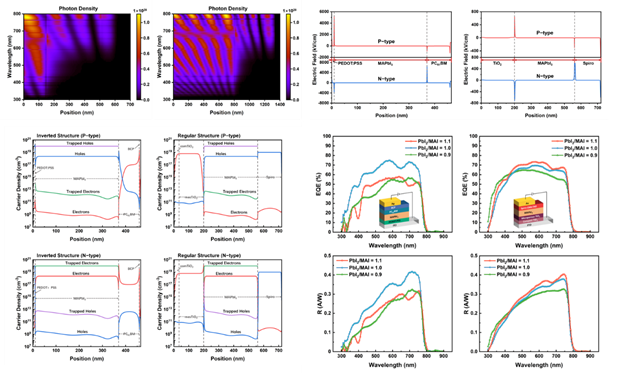Assistant Prof. Wu Dan and his team members from College of New Materials and New Energies, Shenzhen Technology University (SZTU), published an article titled “Revealing the Hidden Mechanism of Enhanced Responsivity of Doped p-i-n Perovskite Photodiodes via Coupled Opto-Electronic Model” in Molecules (JCR: Chemistry Q2, CiteScore: Q1, IF: 4.927) on September 22, together with researchers from Southern University of Science and Technology. Assistant Prof. Wu Dan is the first author and corresponding author, junior student Zhang Hechun the co-first author, and SZTU the first affiliation. The full text of the article can be found at: https://www.mdpi.com/1420-3049/27/19/6223/htm.
Organic-inorganic halide perovskites have demonstrated preeminent optoelectronic performance in recent years due to their unique material properties and have shown great potential in the field of photodetectors. Lots of reported strategies focus on material modifications and the optimization of the structures to enhance the performance of the photodiodes. Though effective, these strategies could only address specific perovskite materials or certain perovskite/transport layer combinations. Previously, the research group adopted a built-in electric field strategy to further improve the dissociation of charge carriers and demonstrated that it can apply to both inverted and regular structures. However, for the widespread adoption of this strategy, an in-depth analysis of device physics is important. Therefore, it is urgent to analyze the physical schema in the perovskite photodiode and reveal the hidden mechanism to enhance the performance of perovskite photodetectors.

The generation rate, carrier density, electric field strength and performance testing of inverted and regular perovskite photodetectors [Photo/https://www.mdpi.com/1420-3049/27/19/6223/htm]
In this work, the researchers constructed a coupled opto-electronic model that is suitable for both inverted and regular structures, prepared doped p-i-n perovskite photodiodes and confirmed the positive effect of the built-in electric field on improving the performance of perovskite photodiodes. Upon illumination, the generation rate of photogenerated carriers is calculated followed by carrier density distribution, which serves as a coupled joint to further analyze the recombination rate, electric field strength, and current density of carriers under different doping types and densities. Moreover, the doping types and densities of the perovskite were regulated by changing the proportion of precursor, and various characterizations were performed to confirm the establishment of a built-in electric field. Based on the optimal conditions, the inverted and regular perovskite photodiodes obtained an external quantum efficiency (EQE) of 74.83% and 73.36% and responsivity of 0.417 and 0.404 A/W respectively. The study explains the hidden mechanism and the doping strategy and provides significant guidance for the future analysis and performance enhancement of perovskite photodiodes.
Drafted by Daisy(姚琦)/ International Cooperation & Student Affairs Office
Revised by International Cooperation & Student Affairs Office
Edited by International Cooperation & Student Affairs Office
